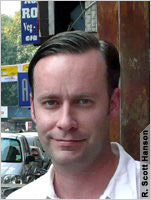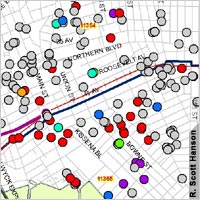DIVERSITY | Offering a place for everyone
25 August 2008
Religious Freedom Laws Help Create Culture of Tolerance
Scholar R. Scott Hanson discusses religious diversity in America

Washington -- An openness to immigration and laws protecting religious freedom helped create the conditions for religious tolerance in the United States, says an expert on immigration, religion and urban issues in America who has researched a neighborhood in New York City he calls “perhaps the most extreme case of religious pluralism in the world.”
That neighborhood is Flushing, Queens, which encompasses more than 200 places of religious worship within 6.5 square kilometers. Queens is one of the five boroughs that make up New York City.
Flushing has become a model for religious pluralism in America, says R. Scott Hanson, a visiting assistant professor of history at the State University of New York at Binghamton and an affiliate of the Pluralism Project at Harvard University. He answered questions about religious diversity during an America.gov webchat August 19.
While many communities in the United States are religiously diverse, Hanson said, the dense concentration of houses of worship and absence of widespread religious conflict in Flushing make it special.
The First Amendment to the U.S. Constitution protects the right to worship freely or not worship at all, and prohibits the government from establishing a national religion. Hanson said the protection of these “basic rights” is essential in creating a culture of tolerance. (See ”The Freedom to Worship and the Courts.”)
“The conditions for diversity seem to stem from a democratic government that permits immigration and protects religious freedom by law,” he observed.
While the efforts of religious institutions and grassroots groups to promote tolerance are important, they are not enough, Hanson said. “In every major world religion, you can find a common message of tolerance, but I think a democratic government that protects religious freedom by law is the only way to guarantee this.”
Flushing has a long history of religious tolerance. In 1657, a group of colonists issued a public notice -- a “remonstrance” -- decrying efforts by the Dutch colonial government to force discrimination against Quakers. The Flushing Remonstrance was one of the earliest arguments for religious freedom in the United States, Hanson said. (See “U.S. Religious Freedom Owes Debt to Colonists’ Radical Document.”)
Today in Flushing, “there are half a dozen Hindu temples, two Sikh gurdwaras, several mosques, Japanese, Chinese, and Korean Buddhist temples, a Taoist temple, over 100 Korean churches, Latin American evangelical churches, Falun Gong practitioners, Jehovah's Witnesses, Mormons ... as well as some of the oldest churches and synagogues in the city,” Hanson said in an essay for the Pluralism Project. (See “One New York City Neighborhood Is a World of Religious Diversity.”)

Most of the recent growth in Flushing and throughout Queens is due to immigration from Latin America, East Asia and South Asia, he told the webchat participants. According to the 2000 census, more than half the residents of Flushing are Asian American, and Queens is now the most ethnically diverse county in the United States.
“I think the real question people are wondering about now for the 21st century is if places like Flushing are now too diverse to still allow for a sense of community,” Hanson said. This can be a problem with recent and first-generation immigrants, who “need time to settle, build institutions, and assimilate” before they feel a part of the community.
However, “Asian Americans who grew up in Flushing are now more politically engaged with the local community than their parents,” he said.
Since the late 1980s, there have been several attempts “to bring various religious and ethnic groups in the community together led by local religious leaders and activists,” Hanson said. These generally are prompted by incidents of vandalism, bigotry or events such as the terrorist attacks of September 11, 2001, “but then [these efforts] fade. As a result, interaction between groups has been limited and relatively superficial, but at least leaders got to know each other.”
“Only very recently has there been more of an organized attempt to bridge the divisions and find common ground,” he said. (See “Different Faiths Team Up to Bridge Differences in New York.”)
“Recent studies show that the 2nd-3rd generations [of immigrants] ultimately become more civically involved -- as you're starting to see in Flushing now with the current City Councilman, John Liu -- the city's first Asian American to hold that office,” Hanson said. Liu, who was born in Taiwan and came to America at age 5, represents northeast Queens on the New York City Council.
“I predict there will be much more civic participation and meaningful interfaith activity in the coming years,” Hanson added.
Hanson is the author of City of Gods: Religious Freedom, Immigration, and Pluralism in Flushing, Queens -- New York City, 1945-2001, scheduled for publication in 2009.
See a transcript of the webchat, Hanson’s map showing places of worship in Flushing and a video produced by the Voice of America.
More information on Hanson’s research is available from the Pluralism Project.
Also see “U.S. Minorities Will Be the Majority by 2042, Census Bureau Says” and Diversity-At Worship.
